
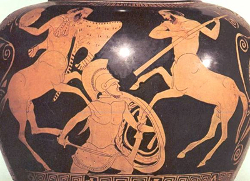
In the readings from Edgar Cayce there is the mention of beings which were both half man and half beast who lived on the Earth until 9,000 BC. Because they were not fully human and usually merely had low animalistic intelligence, these beings were also called the "things" or "automatons". They were being exploited as work slaves for the hard work that didn't require much intelligence. At a later time, this caused a great ethic problem between those of the factions of the sons of Belial - who wanted to keep exploitating them - and those of the Law of One - who proposed more rights, freedom and room for spiritual development for these beings.
Edgar Evans Cayce (Edgar Cayce's son) explained these beings in his book: "Edgar Cayce about Atlantis" (1988), as the result of genetic engineering. The subject and possibility of genetic engineering was still unknown during the time of the readings of Edgar Cayce, thus had not been specifically mentioned in his readings. The first genetically modified organisms were bacteria generated in 1973 and genetically modified mice in 1974.
|
|
|
Regression
hypnotherapist Dolores Cannon mentioned John's story about Atlantis in her book:
"Convoluted Universe (2001)": One time the Atlanteans were conducting genetic experiments,
cloning both animals and human to see if they could do it. They
produced many variations of life forms including mermaids, centaurs and
human-like creatures with horns and goat hoofs (satyrs) and sold them
as pets for them to work on the fields and such, as they were more
animal-like compared to human-like. Eventually they stopped this
themselves as it created disease and it could possible destroy the human race.
The channeled book: "Nefratete, Priesteres in Atlantis (1997)" (Priestess in Atlantis) by Joke Bouwsma briefly described the existence of these half man, half animal beings as secret genetic experiments the common people did not knew about. Their masters used some form of mind control to keep them obedient.
Dr. Cottrell's e-book: "Atlantis Revisited" stated that human
cloning would have been achieved by the ancient Atlanteans. Also
according to Dr. Cottrell and Daan Akkerman they would have
experimented with genetic engineering where
they combined elements from both human and beast.
According to the readings of Daan Akkerman (from: "Lanto 1: Atlantis"), man generally was an emotionless being during the later era of Atlantis (although there were exceptions) that was also still in contact with the fallen angels. These fallen angels however, at that point in time, had lost the ability to manifest themselves in physical bodies due to the further densification of matter, which was the result of the last great changes to the connections of the electro-magnetic grid of the Earth during the second catastrophe of Atlantis. Although they could not continue their practices themselves, they could however bind themselves to physical man, and ever tried in this manner, through man, to create a being without free will that they could form to their own insight. (Those slave workers that Edgar Cayce called the "things" or "automatons".) Through man, they carried on with genetic manipulations at humans, animals and plants, which caused the existence of monstrous creatures, and also the existence of giants and dwarfs.
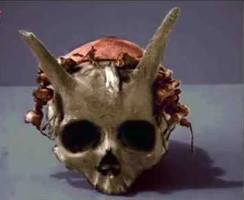 In Greek mythology satyrs were often known as
misschievous
beings and bullies that often looked like half man and half goat. The
satyr could also be closely compared to the "oni" from Japanese folkore, which also had horns and was
likewise often regarded as an evil creature.
In Greek mythology satyrs were often known as
misschievous
beings and bullies that often looked like half man and half goat. The
satyr could also be closely compared to the "oni" from Japanese folkore, which also had horns and was
likewise often regarded as an evil creature.
Perhaps there had ever been found tangible evidence of real satyrs. In the 1880's, large human skeletons were found in a burial mound at Sayre, Bradford County, Pennsylvania. They would have been over a gigantic 7 feet tall and the skulls had pointy projections that looked like horns.
The discovery would have been made by a reputable group of antiquarians but the bones were allegedly stolen after they had been sent to the American Investigating Museum in Philadelphia. Although many believed it was a hoax, similar skulls would have been found near Wellsville, New York and in a mining village close to El Paso, Texas - both during the 19th century.
|
|
|
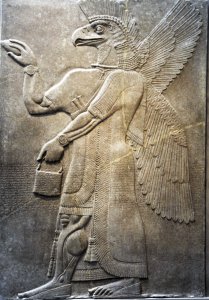 Author Lytle Robinson also mentioned mixed creatures in his book "Edgar Cayce's Story of the
Origin and Destiny of Man (1972)", based on the comprehensive Edgar Cayce readings:
Author Lytle Robinson also mentioned mixed creatures in his book "Edgar Cayce's Story of the
Origin and Destiny of Man (1972)", based on the comprehensive Edgar Cayce readings:
"Overcoming
the monstrosities, the mixtures and the animal influences was
accomplished through rebirth, surgery and evolution towards a more
divine purpose. The animal influences finally disappeared about 9000
B.C. Remnants of these creatures, with their appendages of wings,
tails, feathers, claws and hooves were later depicted accurately in
Assyrian and Egyptian art. The sphinx is a notable example of one of
the earlier monstrosities."
In his readings Edgar Cayce described the so-called
"Temple of Sacrifice", which was a spiritually based
hospital or health center, and the "Temple Beautiful",
which was a school of higher learning and vocational training.
According to Edgar Cayce's material, these temples had nothing to do
with human or animal sacrifices but instead the sacrifice of
the ego
and selfishness was meant, to develop oneself in the way to a more
divine purpose. Edgar Cayce mentioned that there were such temples in
both Altantis and in (early) Egypt around 10,000 BC.
These centers gave hope to these mixtures or "things" that their bodies could be transformed, to heal the body and soul and also to get rid of the animalistic influences which had perverted those beings on a large scale. These reliefs seen above may have to do with the rituals performed in those centers.
"...for,
in the period, there was the Temple of Sacrifice; or that wherein the
body was shed of the animal representations through the sacrificing
of the desires of the appetite, through the changing of self in the
temple service."
(Source: Reading
275-33)
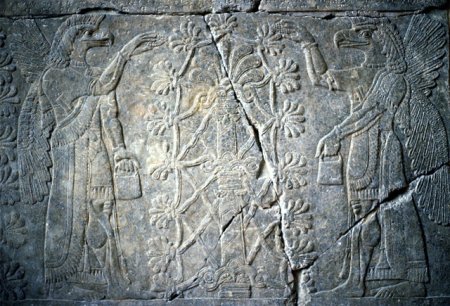
Bass-relief
from Ashurnasirpal II's palace in
Nimrud.
Possibly a depiction of a ritualistic scene from a certain Temple Sacrifice.
Treatments for correction of bodily and mental deformities were accomplished not only through the use of surgery, medicines, electrical therapy, massage, spinal adjustments and the like; but by diet, the vibrations of music, colors, dancing, song, chanting, and most important ones; by keeping a state of profound relaxation and meditation, both for the raising of the spiritual vibration and vitality within the body so that the body will recover better and thus sooner. (Hurt, fear, worry and stress actually lowers one's vibration and should be resolved or avoided as much as possible). There is actually a tight relation between mind and matter where scientists are in present time are just scratching the surface with their theories about quantum mechanics.
"The
passage of individuals through the experiences in the Temple of
Sacrifice was much as would be in the hospitalization, or a hospital
of the present day, when there have become antagonistic conditions
within the physical body, such as to produce tumours, wens[cysts],
warts or such.
Magnify this into the disturbances which
were indicated, or illustrated in conditions where there was the body
or figure of the horse, or the head of the horse with the body of
man; or where there were the various conditions indicated in the
expressions by the pushing of spirit into physical matter until it
became influenced by or subject to same. Such influences we see in
the present manifested as habits, or the habit-forming
conditions.
Then there are, or were the needs for the
attempts to operate, as well as to adhere to diets and activities to
change the natures of the individuals; that their offspring, as well
as themselves, might bring forth that which was in keeping with--or a
pattern of--those influences in which there were souls or spirits
with the idea, or ideal, of seeking light."
(Source:
Reading 281-44)
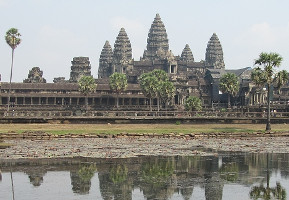
Dr. Douglas James Cottrell described the Temple Beautiful as a regeneration place for those that were the victims of these genetic experiments and suffered from it. The temple complex of Angkor Wat in Cambodia would also have been a health center that was similar to the "Temple Beautiful" and the "Temple Sacrifice", which had been built by those that had migrated from Atlantis (Poseida) and settled within this region. It would originally have been constructed some 10,000 years ago. (Source: "Douglas James Cottrell PhD: Secrets of Angkor Wat", by Rammsteinregeln.)



